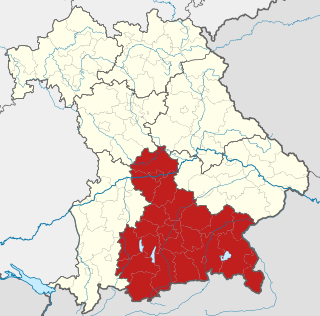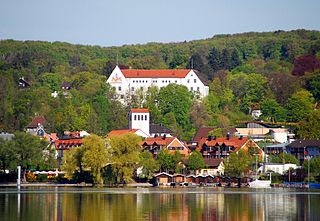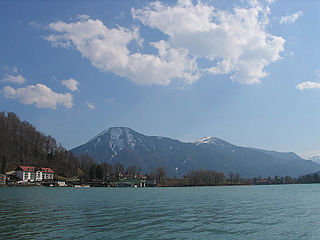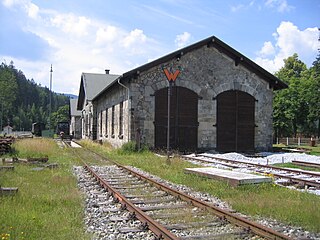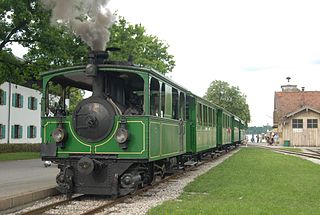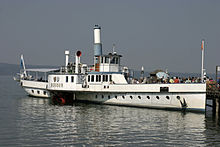


The Bayerische Seenschifffahrt GmbH, or Bavarian Lakes Shipping Company, is a company that operates shipping services on several lakes in the German state of Bavaria. Services operate on the Königssee, the Starnberger See, the Ammersee and the Tegernsee. [1] [2]

Germany, officially the Federal Republic of Germany, is a country in Central and Western Europe, lying between the Baltic and North Seas to the north, and the Alps to the south. It borders Denmark to the north, Poland and the Czech Republic to the east, Austria and Switzerland to the south, France to the southwest, and Luxembourg, Belgium and the Netherlands to the west.

Bavaria, officially the Free State of Bavaria, is a landlocked federal state of Germany, occupying its southeastern corner. With an area of 70,550.19 square kilometres, Bavaria is the largest German state by land area. Its territory comprises roughly a fifth of the total land area of Germany. With 13 million inhabitants, it is Germany's second-most-populous state after North Rhine-Westphalia. Bavaria's main cities are Munich and Nuremberg.

The Königssee is a natural lake in the extreme southeast Berchtesgadener Land district of the German state of Bavaria, near the Austrian border. Most of the lake is within the Berchtesgaden National Park.
The Bayerische Seenschifffahrt company was created in 1997, to operate services on the four lakes that were previously operated directly by the Bavarian state government. These services date back to 1851 (on the Starnberger See), 1879 (on the Ammersee), 1894 (on the Tegernsee) and 1909 (on the Königssee). The company is owned by the state of Bavaria, and has some 160 employees. [3] [4]
The company operates 34 vessels of a variety of types. On the Ammersee it operates a fleet of motor ships, including both propeller-driven and paddle-driven vessels. One of the latter, the Diessen, dates back to 1908 and was originally steam powered. On the Starnberger See and Tegernsee conventional propeller-driven motor vessels are operated. On the environmentally sensitive Königssee only battery-electric launches are permitted, and a fleet of 18 such launches is operated. [1] [3] [5]
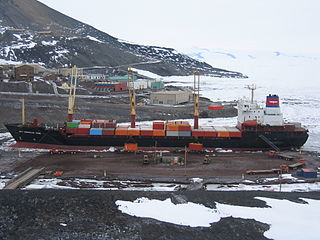
A motor ship or motor vessel is a ship propelled by an internal combustion engine, usually a diesel engine. The names of motor ships are often prefixed with MS, M/S, MV or M/V.

A propeller is a type of fan that transmits power by converting rotational motion into thrust. A pressure difference is produced between the forward and rear surfaces of the airfoil-shaped blade, and a fluid is accelerated behind the blade. Propeller dynamics, like those of aircraft wings, can be modelled by Bernoulli's principle and Newton's third law. Most marine propellers are screw propellers with fixed helical blades rotating around a horizontal axis or propeller shaft.

A paddle steamer is a steamship or riverboat powered by a steam engine that drives paddle wheels to propel the craft through the water. In antiquity, paddle wheelers followed the development of poles, oars and sails, where the first uses were wheelers driven by animals or humans.
Similar passenger services on the Chiemsee, Bavaria's largest internal lake, are operated by the private sector Chiemsee Schifffahrt company. The international Lake Constance White Fleet operates ferry and cruise services on Lake Constance, on which Bavaria has a shore.

Chiemsee is a freshwater lake in Bavaria, Germany, near Rosenheim. It is often called "the Bavarian Sea". The rivers Großache and Prien flow into the lake from the south, and the river Alz flows out towards the north. The Alz flows into the Inn which then merges with the Danube. The Chiemsee is divided into the bigger, north section, in the northeast, called Weitsee, and the Inselsee, in the southwest.
The private sector is the part of the economy, sometimes referred to as the citizen sector, which is run by private individuals or groups, usually as a means of enterprise for profit, and is not controlled by the State.

Lake Constance is a lake on the Rhine at the northern foot of the Alps, and consists of three bodies of water: the Obersee or Upper Lake Constance, the Untersee or Lower Lake Constance, and a connecting stretch of the Rhine, called the Seerhein. These waterbodies lie within the Lake Constance Basin, which is part of the Alpine Foreland and through which the Rhine flows.
